MARIANI’SVirtual
Gourmet
June 30,
2013
NEWSLETTER

❖❖❖
THIS
WEEK
MEXICO
ALL-INCLUSIVES
by Carey Sweet
IS THIS THE END
OF BRENNAN'S NEW ORLEANS?
by John Mariani
NEW YORK CORNER
Daniel
by John Mariani
COLORADO VODKA GOES AGAINST THE GRAIN
by John Mariani
❖❖❖
Mexico
All-Inclusives
by
Carey Sweet
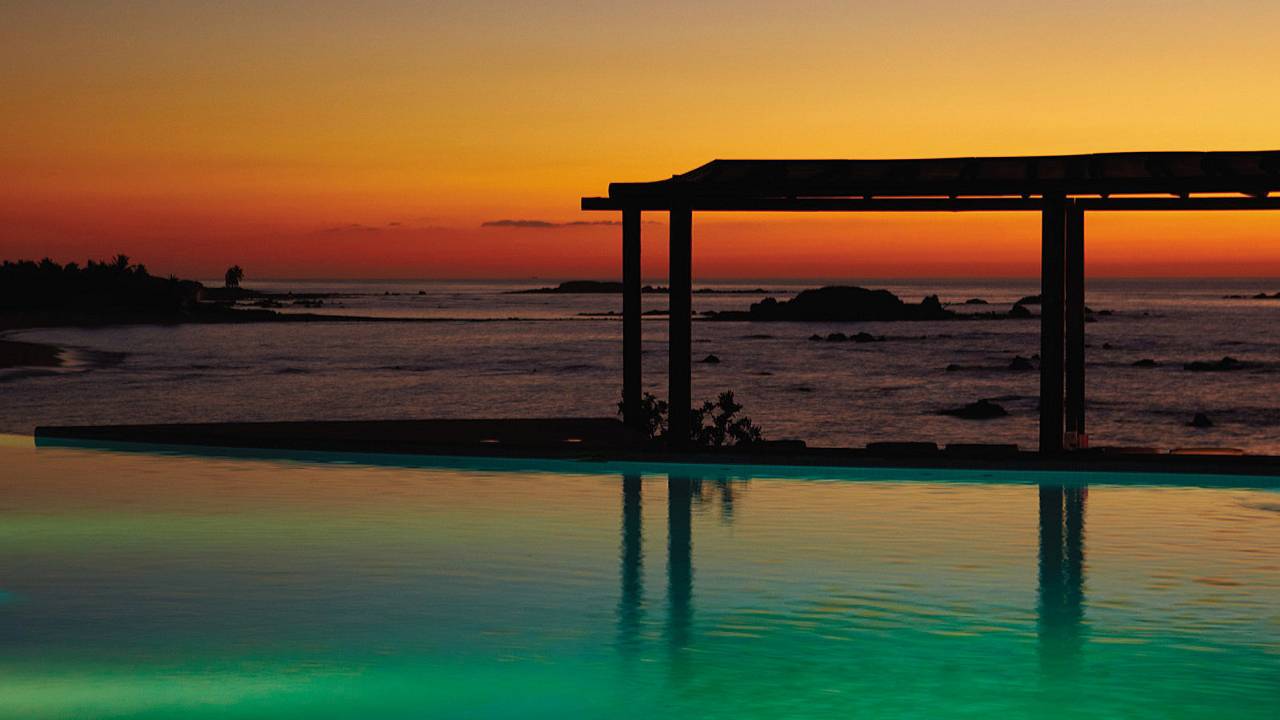
The Four Seasons
Resort Nayarit
They’ve always been two of the worst
words I can hear when considering a hotel: "All
inclusive."
Just
a few years ago, by mistake, I stayed at one of
those depressing tourist traps in downtown Puerto
Vallarta, where the drinks were rotgut, the food
was cheap buffet, and the rooms were built
primarily to withstand abuse from rowdy spring
break crowds.
Yet during a recent visit to the Four Seasons Resort in Punta Mita, Mexico, I heard those exact words. “All-inclusive.” The luxury property on 9.5 miles of Pacific Coast white-sand beaches and turquoise waters now offers a package that includes three meals and unlimited beverages daily. In Riviera Nayarit nearby, other high-end properties have stepped into the all-inclusive arena too, and the trend is spreading across Mexico, to Mazatlán, Cancun and beyond. Finally, it seems, more hotels and resorts are wising up to what an all-inclusive experience could and should be: a delightful way to enjoy a top-notch vacation for a flat fee, with no “what have I done!” feeling in the pit of your stomach when the time comes to pay the bill for all those morning Bloody Marias and late night antojitos.
Some of the newer all-inclusives are surprisingly upscale, layering on the luxury while maintaining good value. At the finer places, that horrible plastic wristband has been done away with, too, replaced by elegant leather or bead bracelets that are so nice, I’ve proudly worn them home. Ultimately, this style of all-inclusive is the perfect combination of classy accommodations, gorgeous settings, and near-endless top quality cuisine and cocktails. Yes, I definitely leave a few pounds heavier, but on the other hand, my wallet isn’t much lighter.
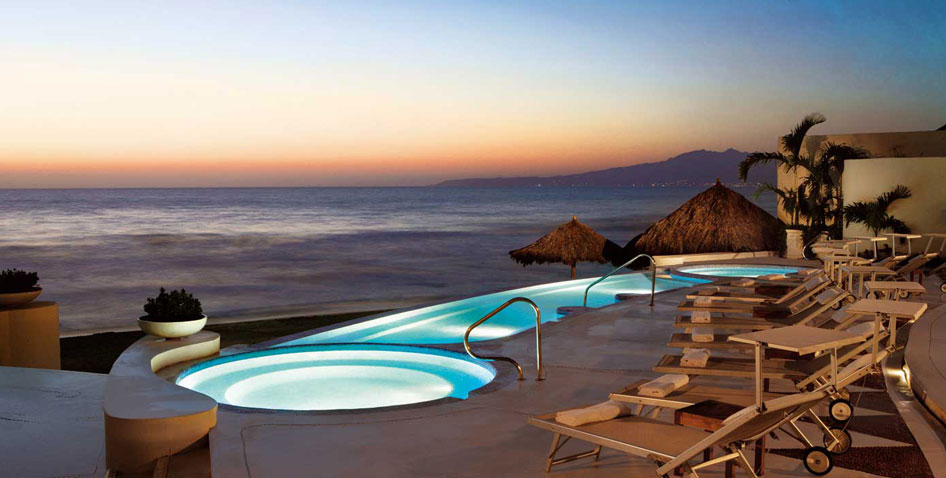
Grand Velas Riviera
Nayarit, Nuevo Vallarta
Spanning a minimum of 1,000 square feet, these are mini palaces, offering a sitting area with sofa, a balcony with more seating, sculptural accents and details down to a pillow menu of eight options (hard to choose,
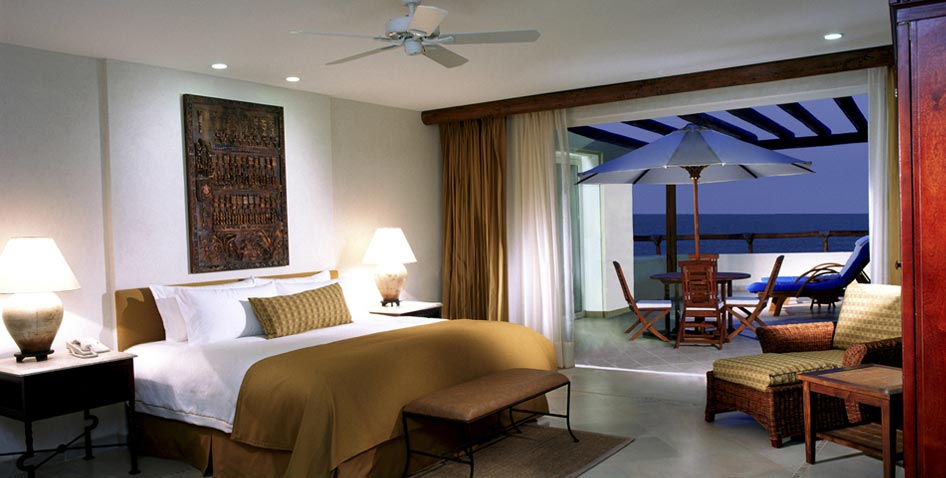 but may I
recommend the soft, 100 percent imported cotton
feather proof fabric model with cord finished double
stitching and imported goose feather stuffing?).
but may I
recommend the soft, 100 percent imported cotton
feather proof fabric model with cord finished double
stitching and imported goose feather stuffing?).Breakfast and lunch are served poolside or at the casual Azul off the lobby, for excellent panko-crusted stuffed crab, sushi, and banana-leaf grilled mahi mahi over plantains, mango and coconut. At dinner, I alternated nights at Frida (below) for fine Mexican specialties such as sea bass in yellow mole, or Lucca for Italian-Mediterranean cuisine like a superb lobster risotto dressed in Cognac essence and pancetta.
For an even fancier evening, there is the classic French restaurant Piaf, where my meals began with a personalized menu silk-screened atop terrine jelly on my plate. Some of my favorite dishes here included caramelized peach and foie gras mousse, and puff pastry lobster swathed in caper butter. I am,
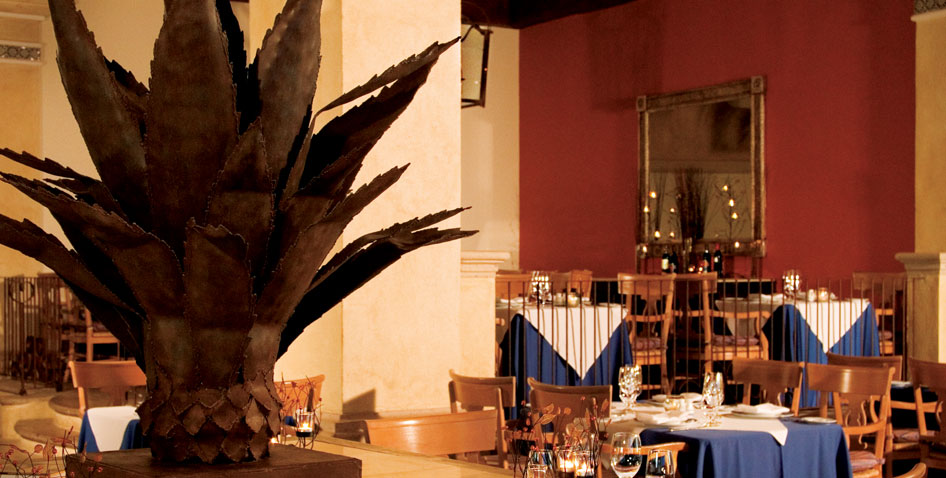 however, a bit
on the fence with the distinctive Mexican flair here,
as this is where I tasted my first (and last) tomato
stuffed with an actual Altoid mint, plus langostino
dressed in garlic-pickled chocolate, olive oil,
vanilla and thyme.
however, a bit
on the fence with the distinctive Mexican flair here,
as this is where I tasted my first (and last) tomato
stuffed with an actual Altoid mint, plus langostino
dressed in garlic-pickled chocolate, olive oil,
vanilla and thyme. The in-suite mini bar is stocked daily with beer, chips and candy, and there’s 24-hour suite service (life is good, nibbling on spinach leaf and seared salmon salad or a Kobe burger at 2 a.m.). At the resort bars, meanwhile, drink choices include premium liquors, creative cocktails, and an impressive selection of wines from around the globe, including notably, Mexico. We can bob with our beverages at the swim-up bar, call for waiter service on our private beach bed, and summon kayaks and boogie boards at the same time.
The Velas team also has put thought into its included activities. I wore myself out with guided bicycle tours, scuba clinics, dance lessons, and Spanish lessons, so I could more politely say, “más que todo por favor.” One afternoon, I participated in cooking class, and for my efforts, got a personalized diploma signed by the resort’s actual executive chefs who had taught us. And here’s another priceless touch: kids are corralled into activities clubs, set afloat in their own private pool, and restricted from adult areas, including Piaf.
For an all-inclusive rate starting at $518 per night, this is a property that’s worth every penny.
Details: grandvelas.com
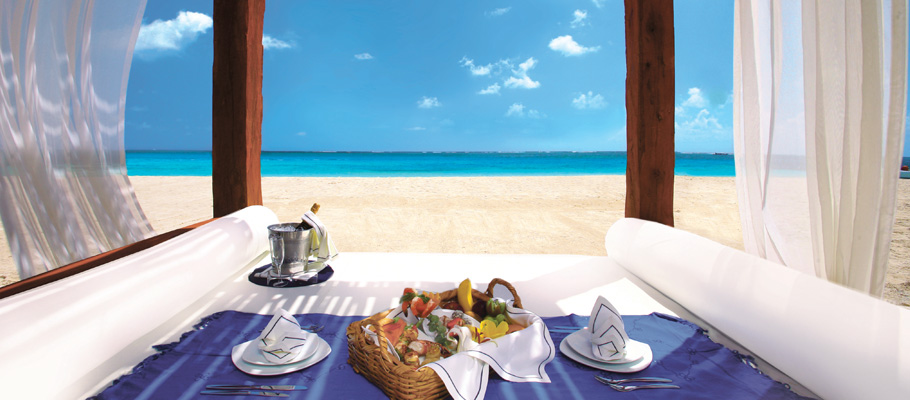
Azul Beach Hotel,
Quintana Roo
Billed as a “Gourmet Inclusive” concept by its parent company, El Dorado Spa Resorts & Hotels Karisma, Azul offers five restaurants, spanning the cuisines of global (at Blue restaurant), Asian (Tainan), Northern Italian (Roma), Latin American (Latino), and Mexican-Caribbean (Chil). A La Mancha “Energy Bar” serves fruit smoothies, coffees, Caribbean sandwiches, brownies and homemade ice cream, while four traditional bars pour premium tequilas in a high-end cantina (Agavero), margaritas on hanging beds (Aquanox), beach beds next to the ocean, or mai tais at the swim-up counters.
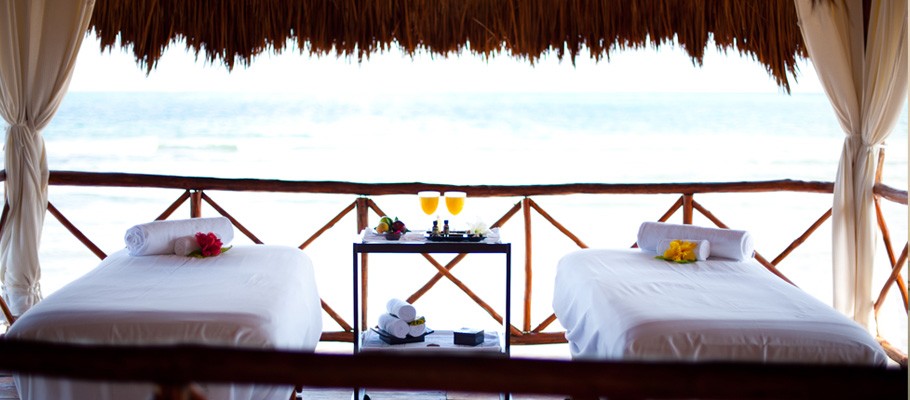 Eating and drinking is a primary
activity at the isolated property. Immediately, I
found my groove: breakfast of chilaquiles at
Blue, a jumbo cookie at the energy bar, a cocktail on
the hanging bed, lunch of shrimp-green tomato-mint
ceviche at Chil, a cocktail on the beach bed served by
a butler, dinner of tempura fish and sushi at Tainan,
then more cocktails and karaoke at Aquanox.
Eating and drinking is a primary
activity at the isolated property. Immediately, I
found my groove: breakfast of chilaquiles at
Blue, a jumbo cookie at the energy bar, a cocktail on
the hanging bed, lunch of shrimp-green tomato-mint
ceviche at Chil, a cocktail on the beach bed served by
a butler, dinner of tempura fish and sushi at Tainan,
then more cocktails and karaoke at Aquanox.To switch things up, sometimes I got room service prettily presented on a white tablecloth cart set with silver, or indulged in the chef’s lobster menu at Blue, bringing signatures like crispy lobster ravioli in sweet-and-sour sauce, lobster bisque, and lobster risotto.
Gentle activities include theater performances that are offered most nights off the lobby (you haven’t seen art until you’ve seen hotel staff doing double duty in an admittedly painful looking Cirque du Soleil-style ballet). You can pay extra for a spa treatment or scuba diving trip, or take a shuttle into town for shopping. Yet I stayed put, swimming, sunning, and lounging in my oversized and recently renovated suite, enjoying the chic mood of dark woods, a free standing Jacuzzi tub, and private terrace. My room featured a separate living area and multiple TVs, which did come in handy when needing to block the noise of the sometimes rowdy adult parties at the swim-up bar in the pool directly outside.
The beach beds are another over-the-top indulgence, as I lay sprawled under a breeze-fluttered canopy mere steps from the water, and a butler ferried everything from sunscreen to novels, ice cold Tecate beer and a picnic lunch of grilled steak and Oaxacan cheese wrap.
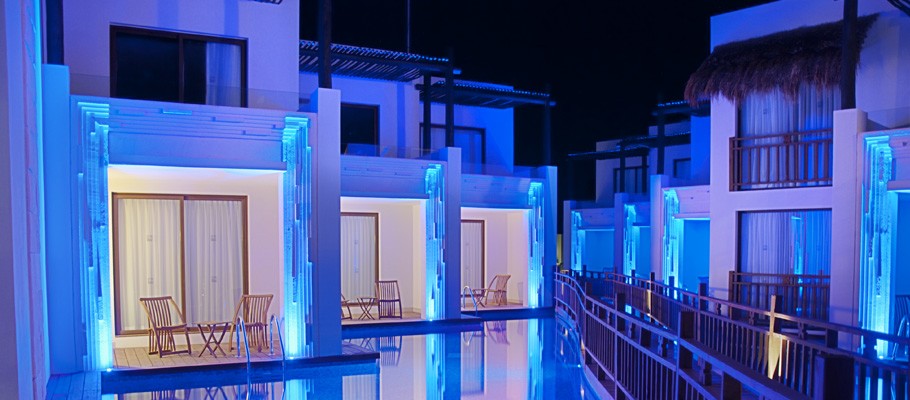
Should I ever find myself with a child, by the way, this is where I would go (and not just because some of the suites include liquor on-tap dispensers). The reason I never heard an unhappy toddler is because here, kids might just be the true stars of the show. The property has co-branded with Fisher-Price and Gerber to roll out the stops.
Upon check-in, each child gets to choose a Fisher-Price toy to borrow throughout the stay, with more toys stocked in the room. Kids get adorable Little People bathrobes that look just like the adult versions, and custom Little People décor for their semi-private rooms. They can play in the Azulitos Play House that looks like a mini FAO Schwartz, enjoy “character” breakfasts with costumed staff, and use cribs, strollers, changing tables, baby bath tubs, baby monitors, bottle warmers and more, free of charge. A parent need never lift a finger, actually, as complimentary Gerber foods are handed out at the Energy Bar, and room service includes movie snacks like popcorn, chocolate chip cookies, and strawberry milk.
El Dorado has another property on the beach nearby, the equally family-friendly Azul Sensatori Hotel, and it offers many of the same amenities as Azul, in a bit more grand format (from $231 per adult). Yet, with 438-suites and plenty of events like weddings plus activities for the teen set, it’s not as cozy for adults seeking a quiet escape.
Info: AzulBeachHotel
Four Seasons Punta Mita
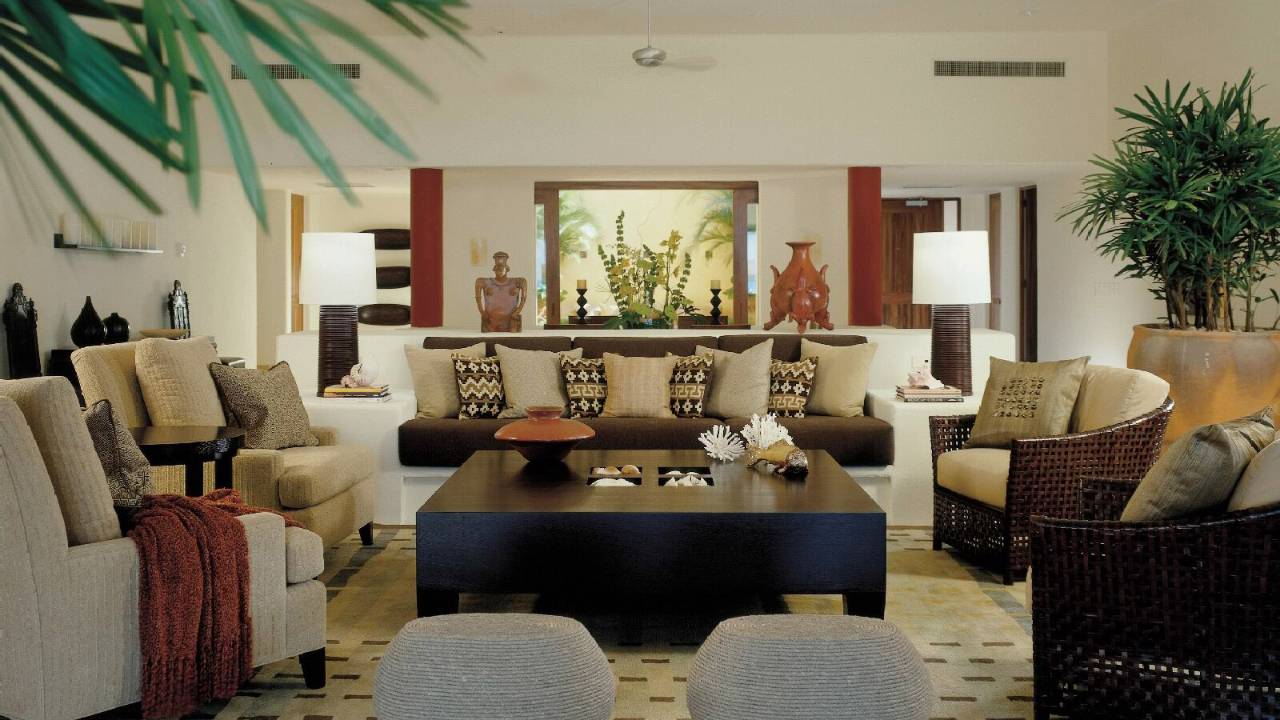 As
I wandered through the lavishly landscaped grounds
directly off the Bahia de Banderas beach, I sipped my
margarita, savoring the fresh mango and habanero, and
convincing myself it was even more delicious since it
was free. I’d been told by my reservationist that this
is the only Four Seasons in the world to offer an
on-going all-inclusive option, though other properties
sometimes put together special inclusive packages for
limited times.
As
I wandered through the lavishly landscaped grounds
directly off the Bahia de Banderas beach, I sipped my
margarita, savoring the fresh mango and habanero, and
convincing myself it was even more delicious since it
was free. I’d been told by my reservationist that this
is the only Four Seasons in the world to offer an
on-going all-inclusive option, though other properties
sometimes put together special inclusive packages for
limited times.Free? Hardly. Yet from $515 per night, the deal includes three meals and unlimited (select) alcoholic drinks for two in any of the restaurants. Margarita numero dos was already on my mind.
The convenience puts the cherry on top for this oasis behind a guard-gated entry on some 3,000 acres about 10 miles north of Puerto Vallarta. Intimate groupings of 141 casita-style rooms and 32 suites overlook two private beaches, the grounds are dotted with tennis courts and swimming pools, and the resort edges up to two Jack Nicklaus-designed golf courses.
And what’s not to appreciate about a resort that has its own 55-foot yacht for charter, complete with bedrooms, a living room and kitchen with dining area, a separate shaded relaxation lounge on the upper deck, and sunning decks on the bow, stern and rear upper level, plus a Wave Runner for guests to ride the sparkling blue waters?
Yes, the yacht is extra. But consider the value of the Four Seasons food alone. When I’ve dined independently at Aramara, the resort’s elegant Asian restaurant, I’ve pumped up an impressive tab quickly, savoring seven-spice rib-eye with kimchee butter, sweet potato fries, lemongrass sauce, or spicy Thai lobster tossed with rice noodles, coconut, Thai basil, lemongrass, cashews, tomatoes and oyster mushrooms.
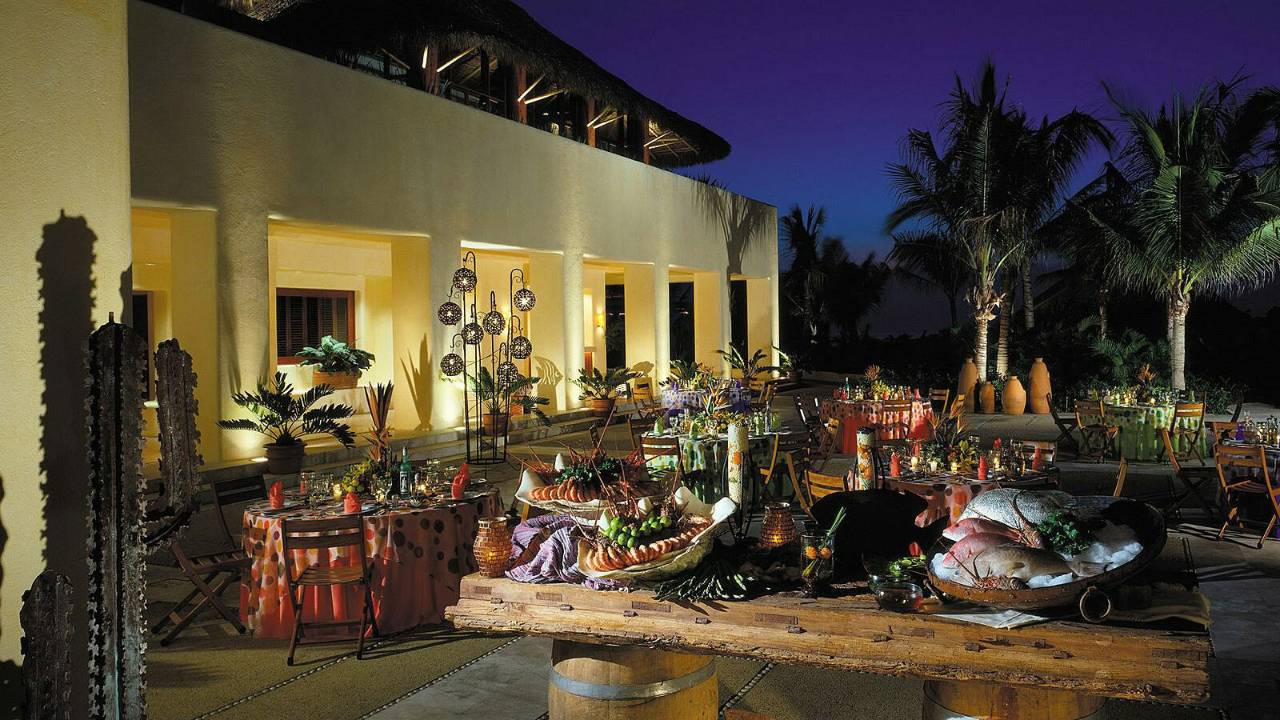 Add in wine
pairings.
Add in wine
pairings.Bahía, the chic Richard Sandoval grill and bar, can get pricey, too, set on Las Cuevas beach and tempting with amberjack decorated in apple, mint, radish, chile de arbol and ponzu sauce, or whole pink snapper marinated in achiote and citrus with avocado, chayote slaw and flour tortillas.
My room had a private plunge pool and a hammock, and the quiet was mesmerizing. In fact, kids are sequestered within their own resort-within-a-resort, in the Oasis complex, a family-oriented building that houses 23 rooms and suites and is encircled by an extravagant Lazy River that meanders for inner tube rides on a gentle current. He or she also receives free dining from the children's menu if under the age of five, and 50 percent off for ages 5 to 12.
There are a few caveats to the savings, such as a minimum stay of three nights. You are not allowed to get in-room dining, caviar, lobster, wine by the bottle, champagne, or premium liquor brands. Yet, that’s hardly a complaint. There’s no wristband of any kind.
Details: http://www.fourseasons.com/puntamita
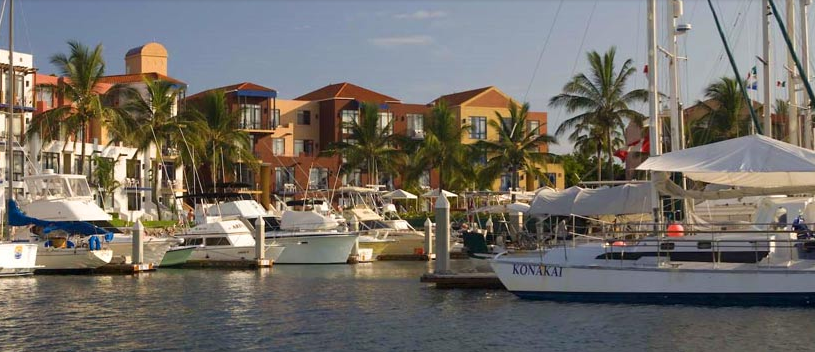
El Cid Marina Beach,
Mazatlán
The distractions are a good thing, because, although satisfactory, the cuisine at this property isn’t a focus (from $345 per night). All meals are included at the four restaurants, as are alcoholic beverages, yet this property could learn from the newer, other all-inclusives. I found myself feeling quite limited in what’s presented.
Built in 1995 but renovated in 2008, the property still feels dated. With 204 suites spread across several buildings in the large compound side-to-side with other hotels, the property isn’t beachfront (you need to take a water taxi to see sand). And there’s
 actually only one real
restaurant on-site – the other spots are snack bars
with limited hours.
actually only one real
restaurant on-site – the other spots are snack bars
with limited hours.First strike: cheap wristbands. Second strike: after showing my bracelet, I had to also provide my room number, even for a simple glass of wine. Third strike: When I asked to see a wine bottle at Las Iguanas Snack Bar, the bartender lugged a gallon jug out from a mini fridge.
Dining at the flagship restaurant, La Marina, covers the basics, but that’s all. Yawners bring a buffet breakfast, then lunch and dinner of an avocado stuffed with shrimp salad, chicken nachos, New York steak and such.
To be fair, had I left the property, I’d have found more choice: the all-inclusive plan includes dining at seven neighboring restaurants and three sister hotels, with options of Mexican, Italian, Argentinean and sushi. Yet leaving requires a shuttle, longish walk, or water taxi, and for someone looking to be lazy like me, that seemed like work.
There’s lots to love about the Marina, with its coveted cove that attracts crazy opulent boats from around the world (a helicopter is a common nautical accessory). The El Cid suites are lovely, spanning terra cotta floors, marble baths, separate living areas and pretty views of the water and swimming pools. Yet suites also include full kitchens, and if that’s convenient, it’s also telling.
Details: elcid.com
❖❖❖
IS THIS THE END OF BRENNAN'S NEW ORLEANS?
by John Mariani
 Just three
months ago I wrote in this newsletter, "Pay no
attention to recent rumors of Brennan's
demise. It's still a family business, the wine
cellar is still one of the best in the South,
and Chef Lazone Randolph, who began here in 1965, is
a demanding steward of Brennan's culinary
traditions.”
Just three
months ago I wrote in this newsletter, "Pay no
attention to recent rumors of Brennan's
demise. It's still a family business, the wine
cellar is still one of the best in the South,
and Chef Lazone Randolph, who began here in 1965, is
a demanding steward of Brennan's culinary
traditions.”
Sadly, I must report that the rumors have proven
true. Without
getting into the details (you can read the Times-Picayune
report
here), I can only say that it is a family
squabble irritated further by competitive real
estate interests in a building at 417 Royal Street
where Brennan’s has resided since 1946.
An earlier family conflict four decades ago resulted
in one branch of the family, headed by Ella and Dick
Brennan, to break away and run Commander’s Palace in
the Garden District, and various members of that
side of the family have opened numerous other
restaurants since, including Brennan’s of Houston. Owen’s
sons Pip, Teddy and Jimmy Brennan, seen in the photo
below in happier times, continued to run Brennan’s,
maintaining its eminence as one of the great New
Orleans classic dining venues, in the tradition of
places like Antoine’s, Galatoire’s, Broussard’s, and
Arnaud’s. 
Over the years (Antoine’s opened in 1840), the city
and its restaurants have had their ups and downs,
none worse than Hurricane Katrina, which destroyed
some restaurants and devastated others. Brennan’s lost
its nonpareil wine cache, and not long afterwards,
Jimmy, who oversaw the wine collection, passed
away. There were charges of mounting losses
and recriminations of mismanagement.
Pip has retained a financial interest but retired
from on-site participation a while ago, leaving Ted
and his daughter to carry on at the restaurant,
while chef Randolph
kept the Creole menu up to date with signature
dishes that included the famous bananas Foster.
I’ve known just about every one of the Brennans on
both sides of the family over the years, and I have
enormous respect for them all, including the three
brothers who ran Brennan’s. I drank
great Burgundy with Jimmy, rode the Bacchus float
with Pip at Mardi Gras, and
swapped stories over daiquiris with Teddy.
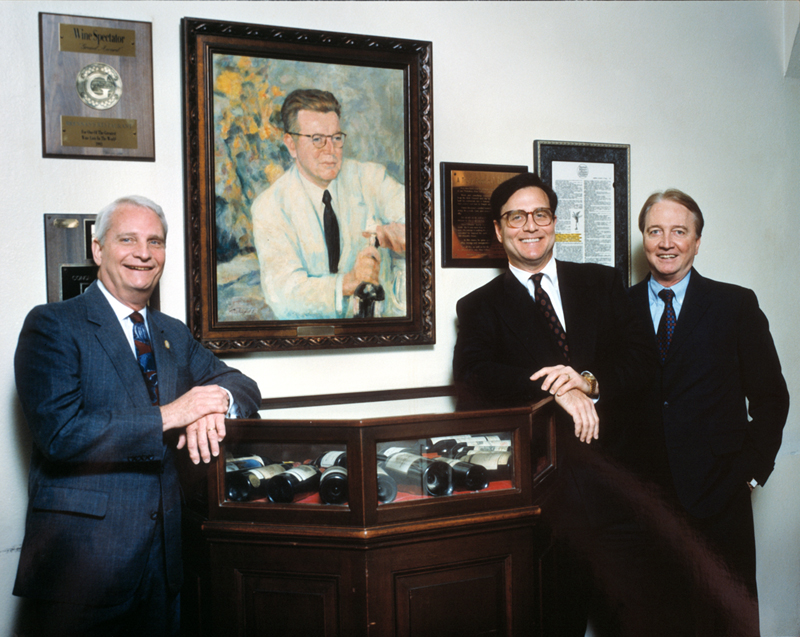 Brennan’s
was always a celebratory place, the restaurant that
pioneered Breakfast at Brennan’s, where champagne
flowed and rich egg dishes were followed by even
richer desserts. Everyone went to Brennan’s--Vivian
Leigh, John Wayne, Robert Mitchum, Barbara Stanwyck,
Robert Taylor, Gary Cooper, Jane Russell and
Tennessee Williams, whose legacy lives on in the
annual Tennessee Williams Festival, when Brennan's
fetes the celebrity participants at a gala dinner.
Brennan’s
was always a celebratory place, the restaurant that
pioneered Breakfast at Brennan’s, where champagne
flowed and rich egg dishes were followed by even
richer desserts. Everyone went to Brennan’s--Vivian
Leigh, John Wayne, Robert Mitchum, Barbara Stanwyck,
Robert Taylor, Gary Cooper, Jane Russell and
Tennessee Williams, whose legacy lives on in the
annual Tennessee Williams Festival, when Brennan's
fetes the celebrity participants at a gala dinner.
The demise, or at least the current lock-up, of
Brennan’s sends the same shiver down New Orleaneans'
spines as when any of their historic restaurants
close: Broussard’s, Christian’s, Bruning’s and
Uglesich’s are all gone, and it’s been touch and go
for Tujaques this past year. Brennan's cuisine
might be reproducible, but its spirit cannot, and
without any Brennans actually running their namesake
restaurant, it would be difficult to resurrect.
I’m hoping that somehow this struggle for ownership
can be brought to a positive conclusion. Brennan’s
is a cherished place, part of the city’s soul, and
without it, the heart of the French Quarter will
murmur if Brennan’s is lost for good.
❖❖❖
by John Mariani
 DANIEL
DANIEL
60 East 65th Street (near Park Avenue)
212-288-0033
Photos by Daniel Krieger, E. Laginel and T. Schauer.
As readers may have noticed, I’ve been on a lucky streak lately of dining at some of NYC’s very finest restaurants: Aureole, Gotham Bar and Grill, and, last week, Daniel, which, since opening in 1993 and in its present location since 1998, has been a graduate school for many of America’s finest young chefs.
Daniel Boulud (to
whom congratulations are in order for his recent
wedding) has for more than twenty years ranked among
the most inventive chefs who have also kept thriving
the rigorous classic traditions of haute French
cuisine. And anyone who believes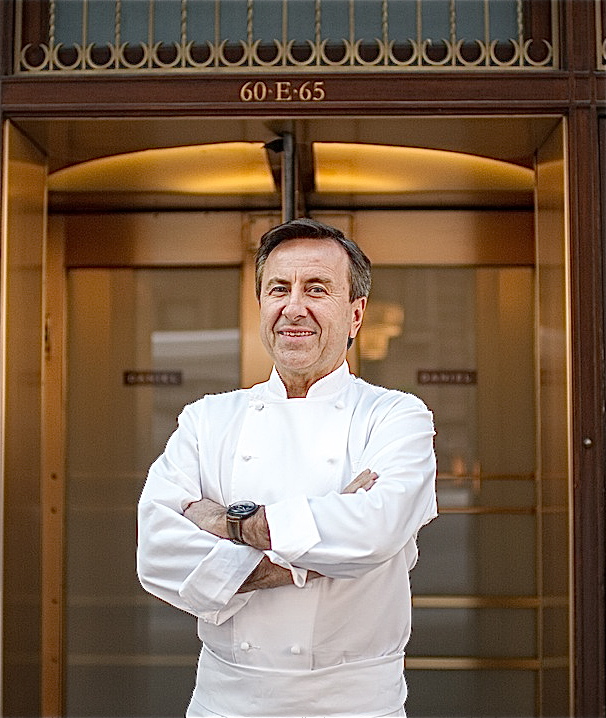 “no one
wants to go to such places anymore,” just try to get
a rez at Daniel on short notice. Good luck.
“no one
wants to go to such places anymore,” just try to get
a rez at Daniel on short notice. Good luck.
Boulud has also been a leader in showing how restaurants lower down in class can be exemplary. His restaurants Café Boulud, Bar Boulud, Boulud Sud, DB Bistro Moderne, Épicierie Boulud, and DBGB, all in NYC, are each different in concept and design, and Boulud keeps a tight rein on all of them. He has also had several non-New York ventures, often management contracts, with varying degrees of success and failure, but his track record is as solid as his commitment. If you choose to dine at Daniel, his flagship, chances are good you’ll find Boulud there in his whites, back in the kitchen, coaxing perfection out of Executive Chef Jean François Bruel, chef de cuisine Eddy Leroux, pastry chef Sandro Micheli, and his other 130 staff.
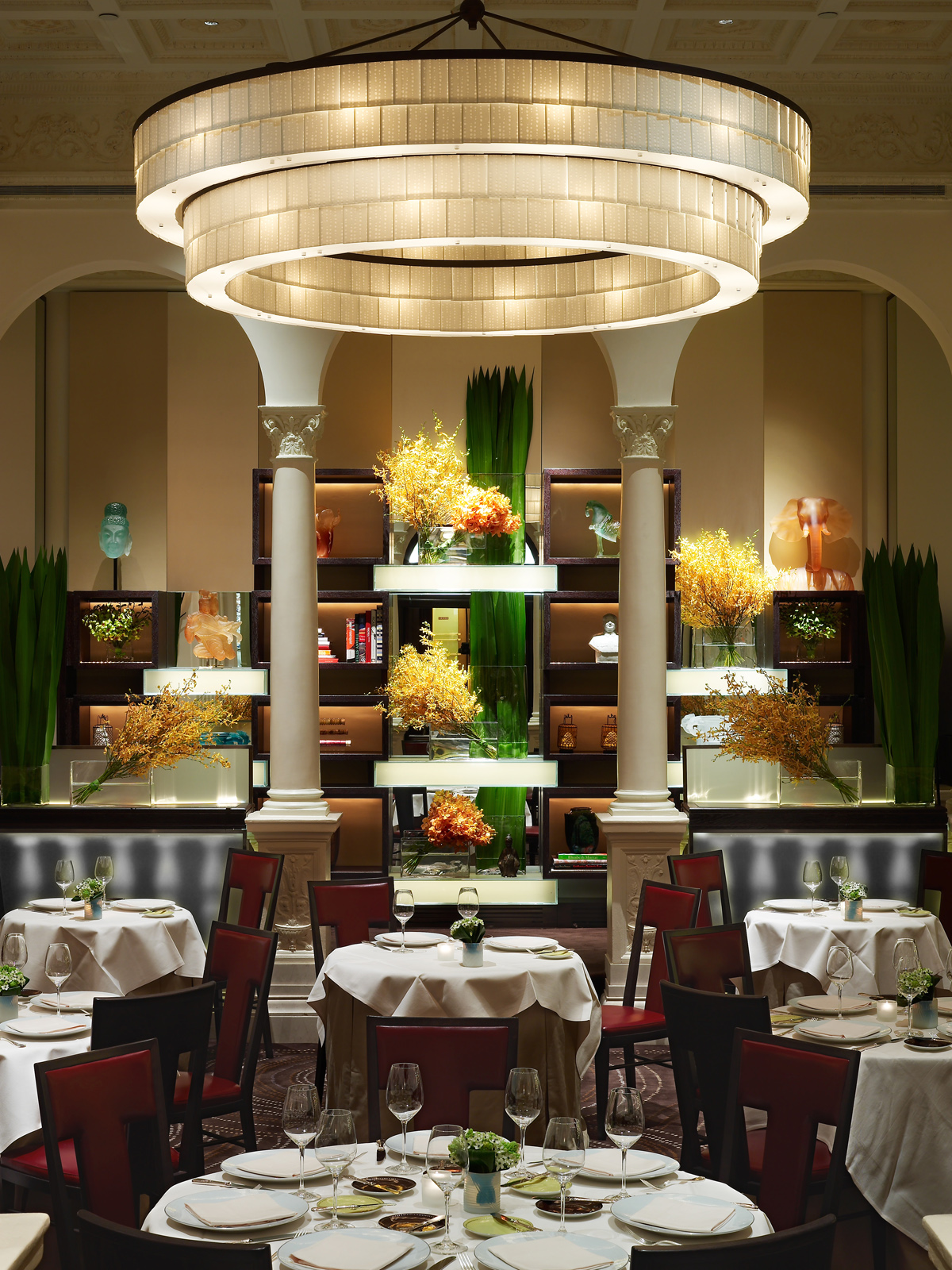 General
manager Pierre Siue keeps it all humming up front,
along with maître d’ John Winterman, who keeps
close tabs on all his guests, so that the next time
you appear at Daniel, you will be remembered to a T.
General
manager Pierre Siue keeps it all humming up front,
along with maître d’ John Winterman, who keeps
close tabs on all his guests, so that the next time
you appear at Daniel, you will be remembered to a T.
Sommelier Raj Vaidya, here since 2009, heads a wine cache of 2,000 selections of the very finest wines in the world; happily, you will find 100 excellent recommendations under $50.
Daniel is composed of a series of dining rooms, including a swank bar and private room, with the main dining area a few steps below the rest. The décor, changed a few years back to a more modern, art déco style, is not overly formal, though it is not a place a gentleman may come without a jacket. Happily, this is still New York. Lighting, I’m sorry to say, is lower than it used to be, so you really can't see who’s coming and going or sitting in the mezzanine tier or to the rear of the room.
The table amenities are of the highest quality, with flowers amid thin glassware and fine silver. Breads are all made on the premises by Mark Fiorentino, and they are difficult to resist, piece by piece—especially since they arrived nearly an hour after we sat down, an unfortunate practice based on the errant belief that people will eat so much bread they won’t order appetizers. Since Daniel serves a prix fixe three-course, $119 dinner, that doesn’t make much sense.
We were treated to
several amuses,
some from the appetizer menu, like a satiny trio of
hamachi, beet-cured with olive oil (right); a
tartare with wasabi and caviar; and a confit with
sorrel coulis and yellow beet. A chilled
minted 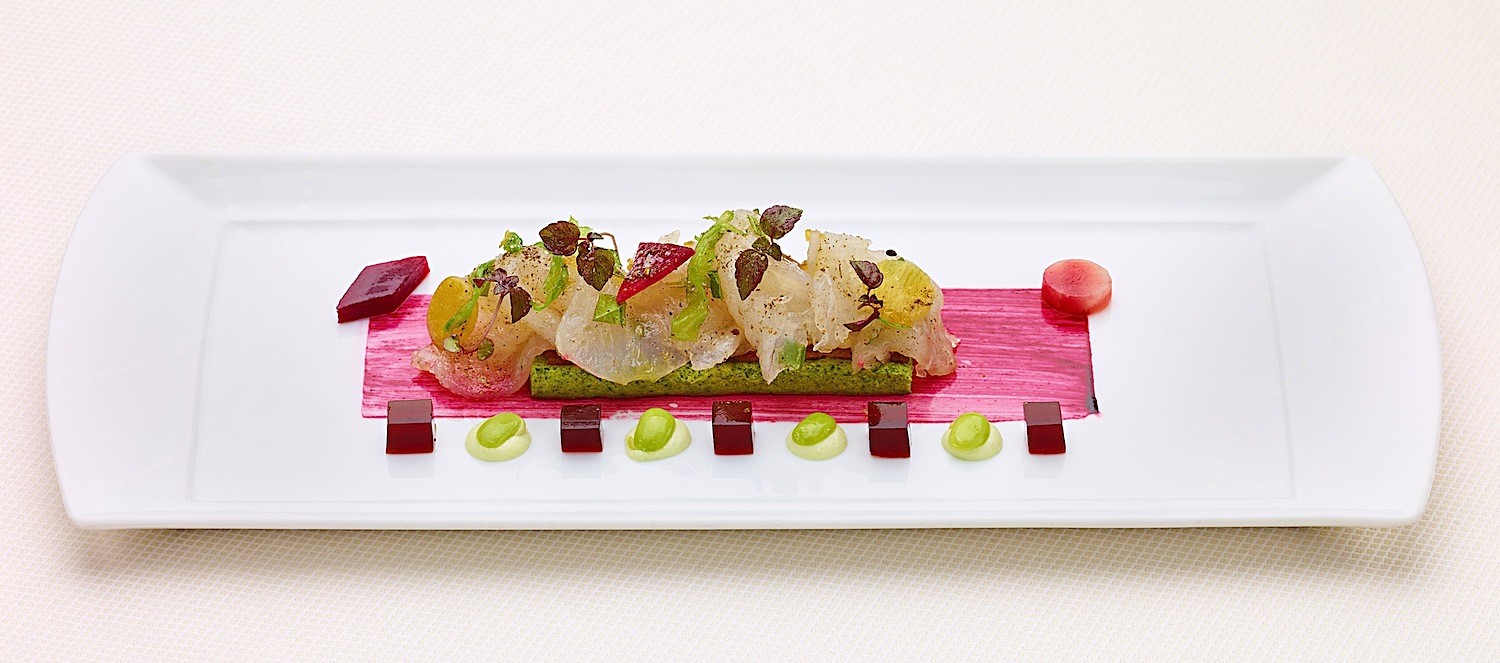 pea soup was
just the thing for a summer’s evening, with nubbins
of smoked sablefish, carrot confit and rosemary
cream.
pea soup was
just the thing for a summer’s evening, with nubbins
of smoked sablefish, carrot confit and rosemary
cream.
In all of Daniel’s cooking there are a number of elements that add much more of the main ingredient, never smothering it with disparate or searing hot flavors. A duck terrine with cured pepper-poached rhubarb, confit of fennel, almond cream and a little sorrel tasted of numerous subtle flavors, each dependent on the other to bring out the best in the creamy terrine.
One of the favorite entrees here is the tasting of suckling pig, composed of a roasted chop with pea fricassée; braised belly with young turnips and savory jus; and the crispy skin of the pig with crunchy pistachio and a Port jus—a dish heartier than one might expect in summer but delicious in every morsel, or what is a/c for?
Two otherwise excellent main courses
were surprisingly salty—monkfish wrapped in spicy
chorizo and stuffed with lobster, accompanied by
wild black riced, yogurt-braised eggplant and an
artemesia salad; and a duo of octopus with stewed
fava beans, Boston lettuce, spring onions.
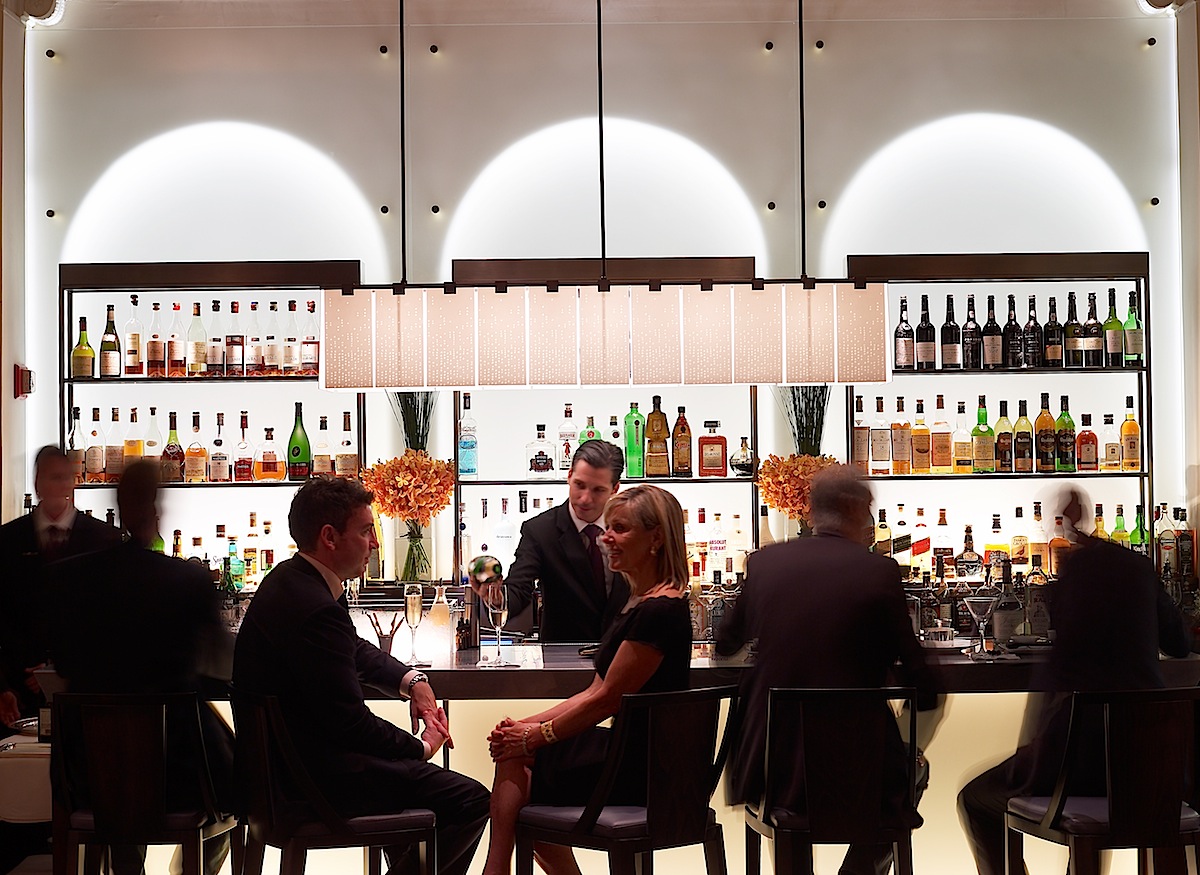 There
is a splendid cheese cart at Daniel, and only the
lateness of the hour prevented us from sampling it,
instead giving ourselves over to an array of
desserts that included marvels like
raspberry-vanilla shortbread with yuzu curd,
caramelized croustillant,
limoncello-berry gelée, and raspberry sorbet;
a coconut vacherin with guava gel, mango-vanilla
swirl and meringue; and any of five chocolate
desserts, including a Kenyan coffee ganache with
dark chocolate
crèmeux, rice krispy chocolate sable,
and coffee ice cream. Pistachio dacquoise came with
white chocolate crisp and pistachio ice cream. Of
course, ending the meal was an array of fine mignardises and
tiny, warm madeleines.
There
is a splendid cheese cart at Daniel, and only the
lateness of the hour prevented us from sampling it,
instead giving ourselves over to an array of
desserts that included marvels like
raspberry-vanilla shortbread with yuzu curd,
caramelized croustillant,
limoncello-berry gelée, and raspberry sorbet;
a coconut vacherin with guava gel, mango-vanilla
swirl and meringue; and any of five chocolate
desserts, including a Kenyan coffee ganache with
dark chocolate
crèmeux, rice krispy chocolate sable,
and coffee ice cream. Pistachio dacquoise came with
white chocolate crisp and pistachio ice cream. Of
course, ending the meal was an array of fine mignardises and
tiny, warm madeleines.
Daniel is a restaurant in the grand tradition that
is nevertheless as modern as any anywhere,
constantly innovative without the need to
sensationalize, consistently refined without
pretension and glamorous without being flashy. You
know what you get and pay for at Daniel—which is a
whole lot more than three courses—and the experience
of dining so well and so beautifully is what
distinguishes this as one of the world’s great
restaurants.
Daniel is open
for dinner Mon-Sat.; Pix fixe dinner $116;
Vegetarian menu $116; pre-dinner supper, 5:30-6:00
PM, with wines included $133. Eight course tasting
menu $220, with wines $130 additional.
❖❖❖
Colorado
Distiller Goes Against the Grain—Makes Vodka with
Taste
by John Mariani
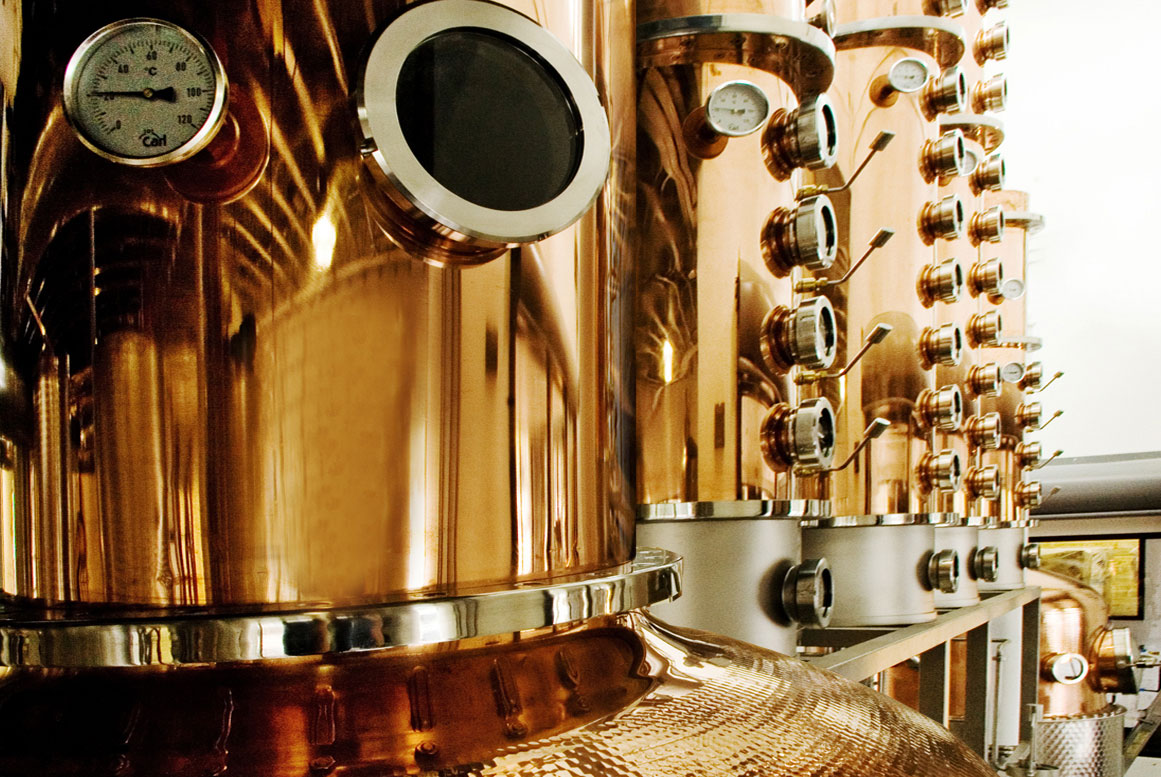 “It takes 13 pounds of
fresh potatoes to make a bottle of our vodka,” says
Mark Kleckner (below),
a former DC-based mergers and acquisitions expert
in the defense business, now CFO and COO of Woody Creek
Distillers in Basalt, Colorado. “Most of the other
American distillers making potato-based vodka use
the kind you find in the bin with wrinkles and
sprouts. The ones you throw away.”
“It takes 13 pounds of
fresh potatoes to make a bottle of our vodka,” says
Mark Kleckner (below),
a former DC-based mergers and acquisitions expert
in the defense business, now CFO and COO of Woody Creek
Distillers in Basalt, Colorado. “Most of the other
American distillers making potato-based vodka use
the kind you find in the bin with wrinkles and
sprouts. The ones you throw away.”
Woody Creek Distillers (WCD), which only began
production last October, gets all its spuds from the nearby
30-acre Scanlon Farm, owned by Kleckner’s partners,
Mary Scanlon, CEO, and her husband Pat, President. She
is a small business owner, overseeing design and
marketing the distillery; Pat was a missile and space network engineer for Lockheed
Martin and IBM; the distillery’s manager, David
Matthews, WCD’s manager, had been a Wall 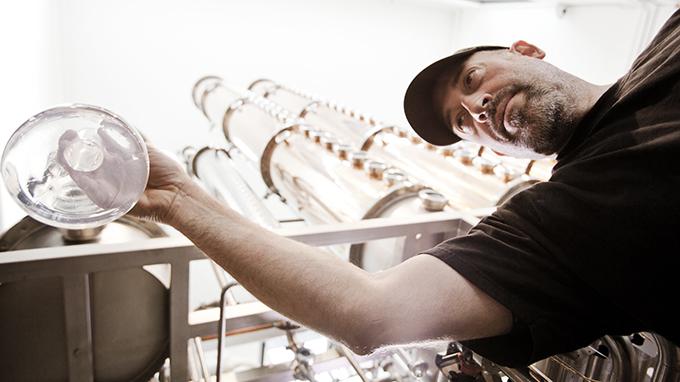 Street trader before sailing
around the world studying distilling and spirits
production.
Street trader before sailing
around the world studying distilling and spirits
production.
Those high-quality potatoes, with lovely names like Colorado Rio
Grande, Chepita and Lady Claire, are washed
and peeled, with some skins kept for fermentation (below), which
takes place in stainless steel tanks; it is then
passed just once through custom-made copper stills
that include 34-foot rectification columns (above), using
Rocky Mountain spring water filtered by reverse
osmosis and softening to de-mineralize it.
The result, which I tasted at the distillery, is an
un- flavored vodka with a remarkable depth of aroma
and taste and a very round, warming effect on the
palate without the eye-squinting bite lesser vodkas
deliver. You taste a vanilla-like flavor, though no
such flavors are added.
WCD is going against
the grain in the vodka world, using artisanal methods
and making small batches of its signature potato vodka
(about 6,000 to 10,000 cases a year) and a reserve
vodka, 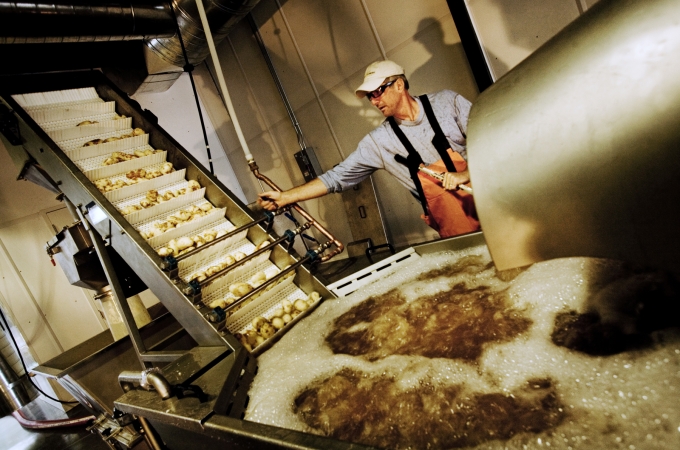 Stobrawa, made from a rare
strain of Polish potatoes, the latter to be released
at the end of July, with only a couple of thousand
bottles available.
Stobrawa, made from a rare
strain of Polish potatoes, the latter to be released
at the end of July, with only a couple of thousand
bottles available.
The company also makes a bourbon-style Colorado
whiskey bourbon-style, a straight rye and a straight
corn whiskey.
“Our
goal by the end of next year is to get up 20,000
cases,” says Kleckner. “The farm still has a big
capacity to produce more ingredients, but if we get to
100,000 cases, that’s the endgame for us to maintain
quality.”
To
that end, WCD eschews the traditional marketing of
vodkas, as being so pure that it has no taste
whatsoever. Indeed, the U.S. standard of identity for
vodka, first promulgated in 1949, dictates that vodka
be a neutral
spirits “distilled from any material at or above 190
proof, reduced to not more than 110 proof and not less
than 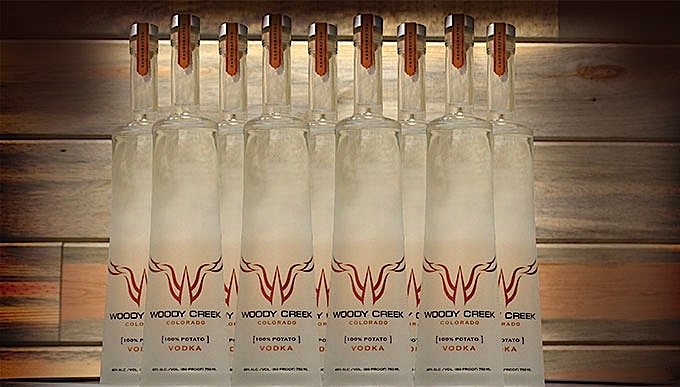 80 proof and,
after such reduction in proof, so treated as to be
without distinctive character, aroma, or taste.”
Which, frankly, sounds pretty dull.
80 proof and,
after such reduction in proof, so treated as to be
without distinctive character, aroma, or taste.”
Which, frankly, sounds pretty dull.
In fact, vodka distillers try so hard to make
their products so “undistinctive” that at a blind
tasting of vodkas I attended some years ago at the
Wyborowa distillery outside of Posnan, Poland, the
company’s own management couldn’t tell the difference
between their own rye-based vodka and their
competitors’ potato-based vodka.
Many vodka makers now add flavorings, from
chile peppers and lemon to bacon and buffalo grass,
but the marketing of most vodkas, whether Russian,
Polish, or American vodkas with names like Deep Eddy
(Texas), Hangar One (California) and Orloff (Maine),
is usually built around claims that the water used in
the process is the purest anywhere.
 Exclusiv
vodka’s water is “naturally filtered through the
limestone mountains of Central Europe.” Grey Goose’s
is “drawn from
500 feet beneath the limestone hills of the Grande
Champagne region of Cognac.” AnestasiA
vodka (Oregon) says it is gluten fee.
Exclusiv
vodka’s water is “naturally filtered through the
limestone mountains of Central Europe.” Grey Goose’s
is “drawn from
500 feet beneath the limestone hills of the Grande
Champagne region of Cognac.” AnestasiA
vodka (Oregon) says it is gluten fee.
Other producers try to
distinguish themselves solely on creative advertising.
Since the 1980s, Absolut has been putting its bottle’s
shape into artwork, landscapes, swimming pools, even
rodeo stalls. Belvedere links up with venues like New
York Fashion Week and Bon Appetit Pub Crawl. Van Gogh
vodka’s marketers insist that, “we are creators of Dutch vodkas with a broad
palette of tastes and colors.” Chopin capitalizes on
Polish composer’s name.
The Tasting Room at Woody
Creek Distillers
“In lieu of hype like that, we believe that the
quality of our product will sell itself,” says
Kleckner, who with his goatee and baseball cap looks a
bit like Billy Joel. “People now want to know what’s
this stuff made of, not what bottle it comes in.”
All of which seems to be paying off: “Our plan was to
be in the black by our third year, but we’re way ahead
of that right now.”
When asked if and former mergers-and-acquisitions guy
like himself would consider a whopping take-over offer
from a major spirits company, Kleckner answered
quickly, “We would certainly listen to an offer but we
didn't leave other careers and do this just to make a
short-term buck. And if we did sell, we would insist
on maintaining all we've worked so hard to build
here.”
TRAVEL ARTICLES WE NEVER FINISHED READING

"We roared across the Wyoming-Utah border at sunset; windows down, stereo cranked, muffler cracked. Behind the wheel was a well-tattooed, pierced 24-year-old. Riding shotgun, a 44-year-old writer with three-day-old stubble (that would be me). And in the back, buried beneath coloring books and blankets, a cherubic boy. We were all three in search of goats."--Bruce Kirby, "In Utah, a 100-Mile Trek With a 4-Year-Old Boy," NYTimes (June 15).

AN ITALIAN BAR RETALIATED BY NAMING A SAUSAGE "THE FRANZ FERDINAND BA-DA-BOOM!"
The Italian government protested to Austria that a Vienna pub was naming its sandwiches after anti-Mafia prosecutors assassinated by mobsters, a sandwich for Giovanni Falcone, killed by a Mafia bombing in 1992, saying the dish was "grilled" like a sausage, and one named after Giuseppe ''Peppino" Impastato, blown up by dynamite, described a s a dish ''baked in a bomb attack like a chicken."
❖❖❖
Any of John Mariani's
books below may be ordered from amazon.com.
 |
My latest book, which just won the prize for best book from International Gourmand, written with Jim Heimann and Steven Heller, Menu Design in America, 1850-1985 (Taschen Books), has just appeared, with nearly 1,000 beautiful, historic, hilarious, sometimes shocking menus dating back to before the Civil War and going through the Gilded Age, the Jazz Age, the Depression, the nightclub era of the 1930s and 1940s, the Space Age era, and the age when menus were a form of advertising in innovative explosions of color and modern design. The book is a chronicle of changing tastes and mores and says as much about America as about its food and drink.
“Luxuriating vicariously in the pleasures of this book. . . you can’t help but become hungry. . .for the food of course, but also for something more: the bygone days of our country’s splendidly rich and complex past. Epicureans of both good food and artful design will do well to make it their coffee table’s main course.”—Chip Kidd, Wall Street Journal.
“[The menus] reflect the amazing craftsmanship that many restaurants applied to their bills of fare, and suggest that today’s restaurateurs could learn a lot from their predecessors.”—Rebecca Marx, The Village Voice. |
"Eating Italian will never be the same after reading John Mariani's entertaining and savory gastronomical history of the cuisine of Italy and how it won over appetites worldwide. . . . This book is such a tasteful narrative that it will literally make you hungry for Italian food and arouse your appetite for gastronomical history."--Don Oldenburg, USA Today. "Italian
restaurants--some good, some glitzy--far
outnumber their French rivals. Many of
these establishments are zestfully described
in How Italian Food Conquered the World, an
entertaining and fact-filled chronicle by
food-and-wine correspondent John F.
Mariani."--Aram Bakshian Jr., Wall Street
Journal.
"Equal parts
history, sociology, gastronomy, and just
plain fun, How Italian Food Conquered the
World tells the captivating and delicious
story of the (let's face it) everybody's
favorite cuisine with clarity, verve and
more than one surprise."--Colman Andrews,
editorial director of The Daily
Meal.com. "A fantastic and fascinating
read, covering everything from the influence
of Venice's spice trade to the impact of
Italian immigrants in America and the
evolution of alta cucina. This book will
serve as a terrific resource to anyone
interested in the real story of Italian
food."--Mary Ann Esposito, host of PBS-TV's
Ciao
Italia. "John Mariani has written the
definitive history of how Italians won their
way into our hearts, minds, and
stomachs. It's a story of pleasure over
pomp and taste over technique."--Danny Meyer,
owner of NYC restaurants Union Square Cafe,
Gotham Bar & Grill, The Modern, and
Maialino.
|
 |
 |
 |
 |
 |
 |
 |
 |
 Everett Potter's Travel Report:
Everett Potter's Travel Report: 
 Eating Las Vegas
is the new on-line site for Virtual Gourmet
contributor John A. Curtas., who since 1995
has been commenting on the Las Vegas food
scene and reviewing restaurants for Nevada
Public Radio. He is also the
restaurant critic for KLAS TV, Channel 8 in
Las Vegas, and his past reviews can be
accessed at KNPR.org.
Click on the logo below to go directly to
his site.
Eating Las Vegas
is the new on-line site for Virtual Gourmet
contributor John A. Curtas., who since 1995
has been commenting on the Las Vegas food
scene and reviewing restaurants for Nevada
Public Radio. He is also the
restaurant critic for KLAS TV, Channel 8 in
Las Vegas, and his past reviews can be
accessed at KNPR.org.
Click on the logo below to go directly to
his site.

Tennis Resorts Online: A Critical Guide to the World's Best Tennis Resorts and Tennis Camps, published by ROGER COX, who has spent more than two decades writing about tennis travel, including a 17-year stretch for Tennis magazine. He has also written for Arthur Frommer's Budget Travel, New York Magazine, Travel & Leisure, Esquire, Money, USTA Magazine, Men's Journal, and The Robb Report. He has authored two books-The World's Best Tennis Vacations (Stephen Greene Press/Viking Penguin, 1990) and The Best Places to Stay in the Rockies (Houghton Mifflin, 1992 & 1994), and the Melbourne (Australia) chapter to the Wall Street Journal Business Guide to Cities of the Pacific Rim (Fodor's Travel Guides, 1991).


MARIANI'S VIRTUAL GOURMET
NEWSLETTER is published weekly. Editor/Publisher: John
Mariani.
Contributing Writers: Christopher Mariani, Robert Mariani,
John A. Curtas, Edward Brivio, Mort Hochstein,
Suzanne Wright, and Brian Freedman. Contributing
Photographers: Galina Stepanoff-Dargery,
Bobby Pirillo. Technical Advisor: Gerry McLoughlin.
© copyright John Mariani 2013
